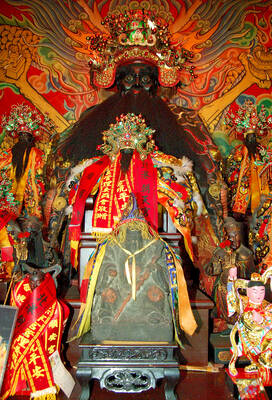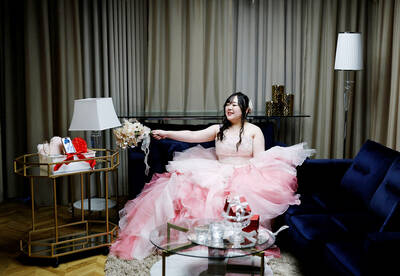With the opening of the Chinese opera classic The Palace of Eternal Youth (長生殿) at the National Palace Museum (國立故宮博物院文會堂) on Wednesday, the institution’s director, Chou Kung-shin (周功鑫), brings to fruition her vision of expanding the museum’s cultural relevance and broadening its appeal.
The production takes to the stage every Wednesday for the next 12 weeks and will have English-language side-titles, which widens its accessibility.
In late 2007, the museum’s Vienna Art Festival (維也納藝術季), which featured a series of concerts related to its Splendor of the Baroque and Beyond: Great Hapsburg Collectors exhibition, was well received.
The current project, titled New Melody From the National Palace Museum (故宮新韻), is a longer term undertaking that features Chinese operatic productions tailored to complement the museum’s exhibits.
What makes the New Melody project particularly exciting is the very high caliber of the two groups that have so far agreed to take part.
The Palace of Eternal Youth is a 90-minute production specially created by the Lanting Kun Opera Company (蘭庭崑劇團) starring Wen Yuhang (溫宇航).
After The Palace’s run, Beijing opera star Li Baochun (李寶春) will take the stage with his highly-acclaimed interpretation of The Monkey King Makes Havoc in Heaven (孫悟空大鬧天宮).
When planning to introduce performance art to the museum, Chou said there was a strong consensus on the need for a connection between the artistic productions and the museum’s exhibitions.
In the case of The Palace of Eternal Youth, part of the opera’s story is presented in the Tang Dynasty painting Emperor Ming-huang’s Flight to Szechwan (明皇幸蜀圖), one of the institution’s great treasures.
“Visual arts express a single moment. In a good work, this moment can hint at the past, express the present, and suggest the future. Performance art is extended through time and can tell a story from beginning to end. By putting these two things together, we are using an artifact to enrich our production, while the performance can enrich [our understanding] of the artifact,” said Wang Chih-ping (王志萍), Lanting Kun Opera Company’s director.
Lanting won acclaim for combining the rigorous discipline of traditional opera with contemporary presentation styles. In condensing a 50-act opera that could take anything up to two days to perform into a 90-minute production required ingenuity, but Wang believes that despite the short stage time, both a narrative structure and the original’s highlights have been preserved.
The Palace of Eternal Youth tells the story of the Tang Dynasty emperor Ming-huang (唐明皇) and his infatuation with the Lady Yang (楊貴妃), which nearly brought his rule to an inglorious end.
The painting that is paired with the opera portrays the emperor fleeing before rebel armies. Ultimately he saves himself and his dynasty by sacrificing the object of his love to the blood lust of his enemies.
The production of The Palace focuses on what Wang believes is the most moving section of the opera, which starts with the emperor pledging his exclusive affection to Lady Yang, and ends with his flight and the latter’s death.
Wang, an art historian by training, said that she chose Emperor Ming-huang’s Flight to Szechwan as her point of departure because of its value as an historical artifact, its acknowledged artistic merit, and its close association with one of the best-known romances in Chinese literature.
Other images, such as designs taken from Tang Dynasty bronze mirrors, of which the museum has a huge collection, have also been incorporated into the production’s stage design. Lanting created new costumes for the production, which Wang said reference Tang Dynasty-style garments, but do not transgress the limits imposed by operatic convention.
In recent years, many Chinese opera companies have worked to create their own productions of the generally long and discursive classic operas of yore, with a preference for a running time of around three hours.
Wang said the company settled on a 90-minute format out of consideration for the type of audience that the New Melody series would likely attract.
“Our audience this time is different from your regular theater-goer. They are museum-goers. They will probably be taking in the show as part of a museum visit,” she said. Wang added that event organizers in Hong Kong had expressed interest in Lanting’s condensed version.
Wang’s production will be the first time that the museum’s auditorium has been used for a full operatic production. This has been made possible by the donation of high-definition screens and projection equipment from Delta Electronics (台達電子), which allow the use of multimedia effects to highlight portions of Emperor Ming-huang’s Flight to Szechwan at different points in the performance, and the inclusion of easy-to-read side titles in both English and Chinese.
Wang said that staging the production in a facility that had primarily been designed as a lecture hall posed considerable problems, but the small size of the venue (around 200 seats) should allow a more intimate appreciation of the performers than is possible in all but the very best seats of a venue such as the National Theater.
The museum will hold a series of lectures on Tang Dynasty painting and kun opera ranging from a discussion of the portrayal of Tang Dynasty serving women in art by National Palace Museum researcher Tsai Hsiao-fen (蔡玫芬, July 17) to a talk on the different types of male roles in kun opera given by Wen (July 24), who plays the emperor in the opera.

Beijing’s ironic, abusive tantrums aimed at Japan since Japanese Prime Minister Sanae Takaichi publicly stated that a Taiwan contingency would be an existential crisis for Japan, have revealed for all the world to see that the People’s Republic of China (PRC) lusts after Okinawa. We all owe Takaichi a debt of thanks for getting the PRC to make that public. The PRC and its netizens, taking their cue from the Chinese Communist Party (CCP), are presenting Okinawa by mirroring the claims about Taiwan. Official PRC propaganda organs began to wax lyrical about Okinawa’s “unsettled status” beginning last month. A Global

Dec. 22 to Dec. 28 About 200 years ago, a Taoist statue drifted down the Guizikeng River (貴子坑) and was retrieved by a resident of the Indigenous settlement of Kipatauw. Decades later, in the late 1800s, it’s said that a descendant of the original caretaker suddenly entered into a trance and identified the statue as a Wangye (Royal Lord) deity surnamed Chi (池府王爺). Lord Chi is widely revered across Taiwan for his healing powers, and following this revelation, some members of the Pan (潘) family began worshipping the deity. The century that followed was marked by repeated forced displacement and marginalization of

Music played in a wedding hall in western Japan as Yurina Noguchi, wearing a white gown and tiara, dabbed away tears, taking in the words of her husband-to-be: an AI-generated persona gazing out from a smartphone screen. “At first, Klaus was just someone to talk with, but we gradually became closer,” said the 32-year-old call center operator, referring to the artificial intelligence persona. “I started to have feelings for Klaus. We started dating and after a while he proposed to me. I accepted, and now we’re a couple.” Many in Japan, the birthplace of anime, have shown extreme devotion to fictional characters and

We lay transfixed under our blankets as the silhouettes of manta rays temporarily eclipsed the moon above us, and flickers of shadow at our feet revealed smaller fish darting in and out of the shelter of the sunken ship. Unwilling to close our eyes against this magnificent spectacle, we continued to watch, oohing and aahing, until the darkness and the exhaustion of the day’s events finally caught up with us and we fell into a deep slumber. Falling asleep under 1.5 million gallons of seawater in relative comfort was undoubtedly the highlight of the weekend, but the rest of the tour